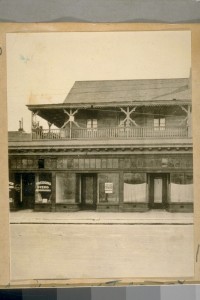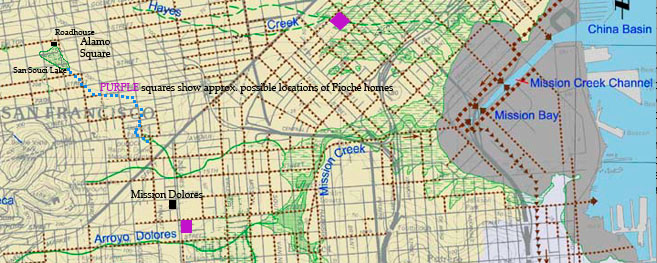A report spreads for decades but makes no sense. How intriguing and frustrating. In a newspaper column from (unconfirmed date) April, 1919, Edward Morphy says that the lake in my neighborhood was destroyed by the 1862 storms with which I am so intrigued. But the detail given makes absolutely no sense. Says Morphy:
…probably the best known landmark of Divisadero street in the pioneer days was the old San Souci roadhouse which stood on the east side of a pretty little lake that then filled the space from Fulton to about midway between Hayes and Fell streets.

(The roadhouse was at the location of the current pet salon at 1333 Fulton Street.)
One night in the winter of 1861-’62—the wettest San Francisco had ever known—the lake overflowed its sandy banks and the water rolled down the valley and into the Mission, cutting its channel ever deeper as it went. In the morning there was only a fraction of the old lake left and the glory of San Souci had materially departed.
The blue dotted line is the approx. path an overflow must have taken, passing the Page Street dune through a gap at what is now Fillmore Street. The purple squares are approximate Pioche home locations. The existence of a “San Souci Lake” is based only on the one source: Morphy. It’s shape is interpolated from the 1859 Coast Survey map.
Morphy goes on: But, down in the valley, in the beautiful block bounded by Seventh and Eighth streets. Mission and Howard, the basin that had formed the lovely gardens of the Pioche home was a sea of water. In its center, with only the cupolas and the roof and part of the second-story visible…
And, in fact, I’ve seen a photo claiming to be “Pioche’s Pond” with the house in deep water—I cannot recall where, but I believe I could find it again.
Morphy’s description of the event is repeated (with or without attribution) in many locations, including in various books, and everyplace from the California Historical Society’s card catalog to an article a few months ago in the Alamo Square Neighborhood Association newsletter. (Look in the right column on the page after the roadhouse photo. Note the doubly inaccurate phrase “Francis Pioche family.” His name was Francois, and he had no family. It was believed and apparently accepted that he lived with his male lover.)
Yes, history is becoming easier than ever to research and serve to the neighbors.
The only problem is that it’s impossible. The block on Mission between 7th and 8th Streets lies in an entirely different watershed from the one San Souci occupies, and it’s not in the “Mission” as claimed. Unless a tunnel existed through Alamo Square into Hayes Valley, the described flooding could not have reached to that property.

As it happens, I’ve seen records of at least three different properties owned by Pioche (Warning: Numerous details in the linked biography are incorrect, as you’ll see just by the storm date given). Pioche’s business location at Clay & Montgomery, may have been owned by him and he seems to have owned dwellings at 806 Stockton, on Dolores just south of the Mission itself, and the block mentioned above, at Mission and 7th.
Could it have been his home on Dolores that was flooded? Perhaps, but the scant and questionable information I’ve found as to its location said it was a short distance south of the Mission Dolores, which would put it just beyond the reach of a flood coming down San Souci Valley…unless the flood was so strong as to surge over the farmed rise upon which the Mission itself sits. Not impossible.
The Dolores location seems to have been sometimes called Pioche’s “Hermitage.”
If you are inclined to investigating mysteries, I’d welcome your participation in this. My friend and neighbor, Chris Dichtel, has found that there were court cases about property damage relating to this flood of water from San Souci Lake. If you want to dig in deeper, let me know and I’ll give you all the (few) other details I have, along with ideas of how to get more. I’d save the fun of discovery for myself, but I have a heap of other stuff pulling on me at the moment. Of course, if you discover the answer, I’ll quote and credit you, and probably cook dinner for you, too!
Interesting, you’re already saying, how water from a storm, after passing through a lake, becomes known as water “from” that lake. Right? Morphy again:
Some time after the San Souci lake overflowed its banks in 1862 and created the Pioche pond in the Mission, a family named Bulger [don’t trust spelling, as it’s from OCR] moved out that way and made their home near the gap cut by the flood water.
Somehow I don’t think the gap referred to was a gap in the huge serpentine rock ridge between San Souci and Hayes valleys! The gap must’ve been down through the dunes in the Wiggle.

Leave a Reply to Jonelle Gausman Cancel reply